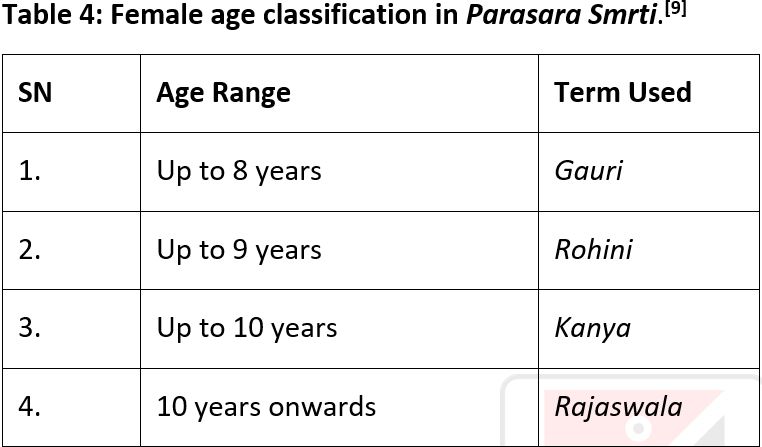Female Development Across Ages: An Ayurvedic Review with Contemporary Correlations
DOI:
https://doi.org/10.21760/jaims.10.4.31Keywords:
Female age classification, Ayurveda, Erikson’s Psychosocial Stage, Freud’s psychosexual stages, Tanner’s classificationAbstract
Background: The age classification system employed in Ayurveda for females offers a methodical way to comprehend physical, physiological, and social transitions across life stages. Texts such as the Charaka Samhita, Harita Samhita, and Parasara Smṛti categorise female development according to mental maturity, reproductive milestones, and dosha predominance. Aim and Objectives: This study focuses on the Ayurvedic classification of female age and contrasts it with contemporary developmental models, such as Erikson's psychosocial phases, Freud's psychosexual theory and Tanner's puberty classification. The goal is to integrate contemporary and traditional perspectives to provide a holistic understanding of female development. Methods: This study methodically gathers information from traditional Ayurvedic texts, peer-reviewed scientific publications, contemporary textbooks, and reliable websites. Selection is based on authenticity, relevance, and credibility, while extraction involves theme categorization and interpretation. For an in-depth analysis, the synthesis integrates modern scientific insights with ancient Ayurvedic wisdom. Results: Ayurvedic classifications align with contemporary models, indicating that while there are universal patterns of growth and maturity, there are also variations brought about by genetic, environmental, and cultural influences. Discussion & Conclusion: A comprehensive, preventative approach to female health is provided by Ayurvedic classification. By combining Ayurvedic and contemporary frameworks, a holistic model for lifetime well-being can be fostered to improve disease prevention, reproductive management, and personalized healthcare.
Downloads
References
Study.com. What is the concept of age? Definition & types—lesson. Available from: https://study.com
Agnivesha. Charaka Samhita, Vidyotini. Sastri K, Chaturvedi G, editors. Vimansthana. Varanasi: Chaukhamba Bharti Academy; 2019. p. 782.
Orenstein GA, Lewis L. Erikson's stages of psychosocial development. In: StatPearls [Internet]. Treasure Island (FL): StatPearls Publishing; Available from: https://www.ncbi.nlm.nih.gov/books/NBK556096/
Harita. Harita Samhita (Ayurvedic text). Edited by Khemraj ShriKrishnadas. Prathamsthana Ch.5, Ver.13. Mumbai: Shri Venkateshwar Press; 1962. p. 28.
Brown BB, Bakken JP, Ameringer SW, Mahon SD. A comprehensive conceptualization of the peer influence process in adolescence. New Dir Child Adolesc Dev. 2008;118:17-44.
Merikangas KR, He JP, Burstein M, et al. Lifetime prevalence of mental disorders in U.S. adolescents: results from the National Comorbidity Survey Replication—Adolescent Supplement (NCS-A). J Am Acad Child Adolesc Psychiatry. 2010 Oct;49(10):980-9. doi: 10.1016/j.jaac.2010.05.017. PMID: 20855043; PMCID: PMC2946114.
Collins WA, Welsh DP, Furman W. Adolescent romantic relationships. Annu Rev Psychol. 2009;60:631-52. doi: 10.1146/annurev.psych.60.110707.163459. PMID: 19035830.
Harita. Harita Samhita (Ayurvedic text). Edited by Khemraj ShriKrishnadas. Prathamsthana Ch.5, Ver.14. Mumbai: Shri Venkateshwar Press; 1962. p. 28.
Parasara. Parasara Samhita (Original text with a literal prose English translation). Edited and published by Manmatha Nath Dutt (Shastri), M.A. Ch.7, Ver.6. Calcutta: Elysium Press; 1908. p. 569.
Monier-Williams M. A Sanskrit-English dictionary: etymologically and philologically arranged with special reference to cognate Indo-European languages. Oxford: Clarendon Press; 1899. OCLC 685239912.
Wisdom Library. Jyotisha glossary. Available from: https://www.wisdomlib.org
Bhattacharya JV. A comprehensive Sanskrit-English lexicon: based on Professor Horace Hayman Wilson's Sanskrit-English Dictionary. Calcutta: Calcutta Press; 1900. Available from: https://www.wisdomlib.org.
Cologne Digital Sanskrit Dictionaries. Monier-Williams Sanskrit-English Dictionary. Available from: https://www.wisdomlib.org.
Sushruta. Sushruta Samhita, Ayurvedatatvasandipika. Sastri A, editor. Sharirsthana Ch.3, Ver.6. Varanasi: Chaukhamba Sanskrit Samsthana; 2001. p. XX.
Lantz SE, Ray S. Freud's developmental theory. In: StatPearls [Internet]. Treasure Island (FL): StatPearls Publishing; 2025. Available from: https://www.ncbi.nlm.nih.gov/books/NBK557914/
World Health Organization. Antiretroviral therapy for HIV infection in infants and children: towards universal access—recommendations for a public health approach: 2010 revision. Geneva: WHO; 2010. Annex H, Sexual Maturity Rating (Tanner Staging) in adolescents. Available from: https://www.ncbi.nlm.nih.gov/books/NBK138588/















